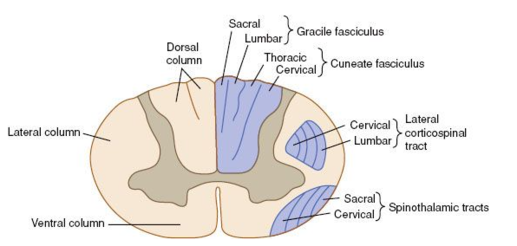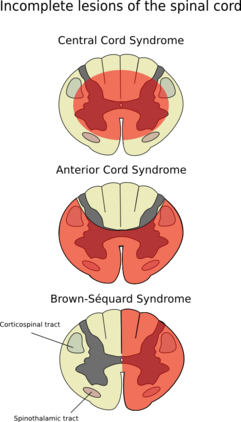Central Cord Syndrome: Difference between revisions
Anas Mohamed (talk | contribs) No edit summary |
No edit summary |
||
| Line 5: | Line 5: | ||
== Introduction == | == Introduction == | ||
Central cord syndrome (CCS) is the most commonly encountered incomplete [[Spinal Cord Injury|spinal cord injury]] (SCI) type. CCS was first described in 1954 by Schneider et al. as a SCI with “disproportionately more motor impairment of the upper than of the lower extremities, bladder dysfunction, usually urinary retention, and varying degrees of sensory loss below the level of the lesion.”<ref>Divi SN, Schroeder GD, Mangan JJ, Tadley M, Ramey WL, Badhiwala JH, Fehlings MG, Oner FC, Kandziora F, Benneker LM, Vialle EN. [https://www.ncbi.nlm.nih.gov/pmc/articles/PMC6512200/ Management of acute traumatic central cord syndrome: a narrative review.] Global spine journal. 2019 May;9(1_suppl):89S-97S.</ref> | Central cord syndrome (CCS) is the most commonly encountered incomplete [[Spinal Cord Injury|spinal cord injury]] (SCI) type. CCS was first described in 1954 by Schneider et al. as a SCI with “disproportionately more motor impairment of the upper than of the lower extremities, bladder dysfunction, usually urinary retention, and varying degrees of sensory loss below the level of the lesion.”<ref>Divi SN, Schroeder GD, Mangan JJ, Tadley M, Ramey WL, Badhiwala JH, Fehlings MG, Oner FC, Kandziora F, Benneker LM, Vialle EN. [https://www.ncbi.nlm.nih.gov/pmc/articles/PMC6512200/ Management of acute traumatic central cord syndrome: a narrative review.] Global spine journal. 2019 May;9(1_suppl):89S-97S.</ref> | ||
== Clinically Relevant Anatomy == | == Clinically Relevant Anatomy == | ||
[[File:Somatotopic arrangement of spinal cord.PNG|thumb| | [[File:Somatotopic arrangement of spinal cord.PNG|thumb|517x517px|Somatotopic arrangement of spinal cord]] | ||
To understand the clinical presentation and pathological process, it is very essential to have knowledge about somatotopic arrangement of tracts in [[Spinal cord anatomy|spinal cord]]. Somatotopic arrangement of tracts mainly lateral [[Corticospinal Tract|corticospinal tract]], dorsal column pathway, and lateral [[spinothalamic tract]] are important to understand. | To understand the clinical presentation and pathological process, it is very essential to have knowledge about somatotopic arrangement of tracts in [[Spinal cord anatomy|spinal cord]]. Somatotopic arrangement of tracts mainly lateral [[Corticospinal Tract|corticospinal tract]], dorsal column pathway, and lateral [[spinothalamic tract]] are important to understand. | ||
== Epidemiology == | == Epidemiology == | ||
| Line 44: | Line 43: | ||
== Clinical Presentation == | == Clinical Presentation == | ||
[[File:Incomplete Spinal Cord Injury.png|thumb|422x422px|Incomplete Spinal Cord Injury]]The upper extremities are more severely affected than the lower extremities. In particular, the hands and forearms are most affected. Bladder dysfunction, typically urinary retention and bowel and sexual dysfunction, may be present in more severe cases. | |||
The upper extremities are more severely affected than the lower extremities. In particular, the hands and forearms are most affected. Bladder dysfunction, typically urinary retention and bowel and sexual dysfunction, may be present in more severe cases. | |||
At the level of injury, lower motor neuron lesion type of features is seen whereas below the level of injury upper motor neuron lesion kind of features are seen. | At the level of injury, lower motor neuron lesion type of features is seen whereas below the level of injury upper motor neuron lesion kind of features are seen. | ||
Revision as of 06:39, 29 December 2020
Top Contributors - Manisha Shrestha, Kim Jackson, Lucinda hampton, Anas Mohamed, Stacy Schiurring and Rosie Swift
Introduction[edit | edit source]
Central cord syndrome (CCS) is the most commonly encountered incomplete spinal cord injury (SCI) type. CCS was first described in 1954 by Schneider et al. as a SCI with “disproportionately more motor impairment of the upper than of the lower extremities, bladder dysfunction, usually urinary retention, and varying degrees of sensory loss below the level of the lesion.”[1]
Clinically Relevant Anatomy[edit | edit source]
To understand the clinical presentation and pathological process, it is very essential to have knowledge about somatotopic arrangement of tracts in spinal cord. Somatotopic arrangement of tracts mainly lateral corticospinal tract, dorsal column pathway, and lateral spinothalamic tract are important to understand.
Epidemiology[edit | edit source]
- The estimated incidence of spinal cord injury in the United States is 17,000 new cases each year. The majority of patients are males involved in car accidents, falls or acts of violence.
- Incomplete injuries are currently the most frequent neurological category with about 60%. Among incomplete cord injuries, central cord syndrome is the most common type, ranging from 40 to 70% of cases.
- It can occasionally be missed if the patient has mild symptoms at the initial presentation.
- Studies reported a bimodal age distribution, however, with about 30% between 10 to 30 years old and 70% older than 40 years.
- males are most affected than females.[2]
Mechanism of Injury[edit | edit source]
In elderly,
- underlying cervical spondylosis (stress defects) with minor hyperextension trauma or fall may cause CCS (most common). b v
- This usually happens with a forward fall while striking the chin, and having the neck extend backward at the time of the fall.[3]
- >90% of patients with CCS aged >40 years have been shown to have underlying cervical spine conditions, such as spondylosis with osteophyte formation, canal stenosis, and ossification of the posterior longitudinal ligament.[4]
In adult,
- sustain higher velocity of trauma, leading to cervical spine instability/fracture (most common)or traumatic disk herniation.[3]
Less common causes including,
- Cervical spondylosis,
- Atlantoaxial instability,
- Tethered cord,
- Spinal arthropathies.
- Syringomyelia
- Spinal epidural abscess[3][4]
Pathological process[edit | edit source]
- CCS originally was theorized to consist of injury to the central gray matter and the central portion of the long tracts, with preservation of the peripheral structures.
- Injury to the central gray matter and cord hemorrhage were thought to be the main causes of CCS.
- However, recent studies have shown that the lateral cortical spinal tract in the mid to upper cervical spine contains the main area of pathologic abnormality.
- Patients with CCS exhibit wallerian degeneration of the axonal tracts distal to the zone of injury in the lateral corticospinal tracts.
- The motor-evoked potentials were more severely affected than the somatosensory-evoked potentials, and the hand musculature, particularly the abductor pollicis brevis, was most severely affected.
- Thus, injury to the large myelinated axons of the lateral corticospinal tract seems to be the main cause of the deficits associated with CCS. This explains the primary involvement of the fine motor movements of the distal upper extremity.[4]
Clinical Presentation[edit | edit source]
The upper extremities are more severely affected than the lower extremities. In particular, the hands and forearms are most affected. Bladder dysfunction, typically urinary retention and bowel and sexual dysfunction, may be present in more severe cases.
At the level of injury, lower motor neuron lesion type of features is seen whereas below the level of injury upper motor neuron lesion kind of features are seen.
Diagnostic Procedures[edit | edit source]
Rapid and accurate diagnosis is essential in a patient with suspected SCI.
A full radiographic evaluation should be done, typically consisting of crosstable lateral, AP, and open-mouth odontoid views.
Computer Tomography (CT) is frequently performed either in addition to or instead of traditional radiography. Because of the approximately 10% to 20% incidence of noncontiguous spine fractures, when a cervical spine fracture is identified via CT.
MRI can be useful in further assessing the presence of soft-tissue injury or cord compression. MRI evaluation typically includes axial, coronal, and sagittal sections of T1- and T2- weighted images.[4]
Outcome Measures[edit | edit source]
In evaluating a patient with SCI, it is essential to determine the extent of neurologic injury (ie, incomplete versus complete). Incomplete injuries have a greater chance for neurologic recovery, whereas motor recovery is achieved in only 3% of patients with complete injury during the first 24 hours and never after 24 to 48 hours.
With the help of American Spinal Cord Injury (AISA) Impairment Scale [AIS], the neurological level and complete -incomplete spinal cord injury level can be identified.
An accurate system of the clinical neurologic assessment and recording influences treatment decisions allows for reliable serial monitoring, and provides prognostic information.
For further details about outcome tools in SCI: Spinal Cord Injury Outcome Measures Overview
Management / Interventions[edit | edit source]
add text here relating to management approaches to the condition
Prognosis[edit | edit source]
- The prognosis for central cord syndrome varies, but most people whose syndrome is caused by trauma have some recovery of neurological function.
- Those who receive medical intervention soon after their injury often have good outcomes.
- Improvement occurs first in the legs, then the bladder, and may be seen in the arms. Hand function recovers last, if at all.
- Recovery is generally better in younger patients, compared to those over the age of 50.[5]
Differential Diagnosis[edit | edit source]
- Middle Cerebral Artery (MCA) stroke.
Resources[edit | edit source]
add appropriate resources here
References[edit | edit source]
- ↑ Divi SN, Schroeder GD, Mangan JJ, Tadley M, Ramey WL, Badhiwala JH, Fehlings MG, Oner FC, Kandziora F, Benneker LM, Vialle EN. Management of acute traumatic central cord syndrome: a narrative review. Global spine journal. 2019 May;9(1_suppl):89S-97S.
- ↑ Schadler P, Shue J, Girardi F. Central Cord Syndrome: A Review of Epidemiology, Treatment and Prognostic Factors. JSM Neurosurgery and Spine. 2016;4:1075.
- ↑ 3.0 3.1 3.2 Ameer MA, Gallagher MA, Gillis CC. Central Cord Syndrome. StatPearls [Internet]. 2020 Jan.
- ↑ 4.0 4.1 4.2 4.3 Nowak DD, Lee JK, Gelb DE, Poelstra KA, Ludwig SC. Central cord syndrome. JAAOS-Journal of the American Academy of Orthopaedic Surgeons. 2009 Dec 1;17(12):756-65.
- ↑ National Institute of Neurological Disorders and Stroke (NINDS). Central Cord Syndrome Information Page [Internet]. Available from:https://www.ninds.nih.gov/Disorders/All-Disorders/Central-Cord-Syndrome-Information-Page [ last accessed: Dec 26, 2020]








